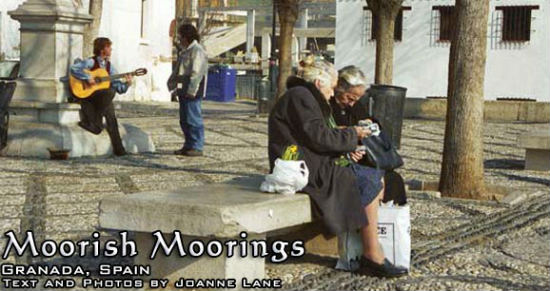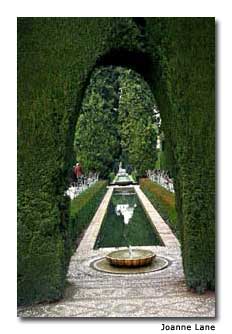

I am sitting in a bar in Spain’s Andalusian state, Granada, where I have been drinking glasses of beer for the last two hours in order to get free plates of food.
I don’t even like beer, and yet I’ve lost count of how many I’ve had — always a bad sign. But it’s been worth the effort. Tapas are mini-snacks, and there are infinite varieties, from calamari rings to spinach with chick peas.
There are two stories about the origins of tapas, which means “lid” in Spanish. The first goes that combining food with alcohol was a way of ensuring people didn’t drink on empty stomachs. The alternative is that drinks were traditionally covered by a small plate of food.
Whichever it is, it could well be the reason why siestas are so quiet in Granada — everyone is home sleeping it off, or at least the foreign tourists not used to this style of eating are resting. However, I’ve ceased to mull over the origins of the tradition, and I am wondering how I can get off the stool and stagger outside.
The bar attendant has turned the television to a soccer match, and everyone is engrossed in it. So I am sure I can slink by unnoticed past the mess of napkins and toothpicks on the floor at the foot of the bar, the most telltale sign of a tapas feast, and make use of the afternoon light in this picturesque town.
Granada was the capital of the last Moorish kingdom in Spain from the 13th through the 15 th centuries, and the city is full of reminders of its Arabic past, with baths, Arabic teterías (tea shops) andalcaicerías (markets).
Granada houses Spain’s best Moorish constructions, the most magnificent of which is the Alhambra. This old fortress with palaces and gardens perches above the hillside town with a snowy vista of the Sierra Nevada mountain range in the background. There are also Baroque churches, Gothic chapels, monasteries, palaces, convents and cathedrals.
I’d spent the morning wandering around the whitewashed houses of the Moorish Sacromonte and Albayzin neighborhoods, noting husky old men peering from doors of the bars. While a group of people gathered around a man fixing a water main offered advice, a dog tried to steal my map.
I’d been hassled by herb sellers, a gypsy woman with badly applied eyeliner who wanted to read my palm for an incredible sum, and hippies who needed soap more than the cigarettes they asked for. In the end I had sat down in the Mirador de San Nicolás Plaza with other tourists and locals who had spilled from local restaurants to enjoy the sun and beauty of this spot overlooking Granada.
There were two grandmothers with enough colored hair clips to keep an army of small girls happy, a man playing a guitar, two gypsy girls pestering tourists, and the hazy panorama of the famous Alhambra and the Sierra Nevada mountains behind. The moment was so surreal I lost myself for two hours, and have only moved since then to this bar where I am almost unable to leave my chair.
It is in moments like these that Granada begins to weave its spell. Washington Irving describes this phenomenon in Tales of the Alhambra,in which he speaks of the intertwining of life, religion and architecture, where everything is similar but nothing is the same. However, perhaps Ernest Hemingway’s party-riven accounts of Spain in his novel The Sun Also Rises may be closer to your own experience if you visit too many tapas bars.
Much has been written about the beauty of La Alhambra fortress, palace, patios and gardens, and none of it is exaggerated. Its combination of Islamic art, architecture and gardening is visually stunning. La Alhambra is made up of the military fortress of Alcazaba, the Royal Palace (home of the Alhambra Museum) and the gardens of the Generalife Palace.
The Alcazaba dates from the 11th to 13th centuries. The Royal Palace, the centerpiece, was built for Granada’s rulers in the 14th and 15th centuries. The intricate stonework, and inner rooms and courtyards are breathtaking. The Generalife, the summer palace of the sultans, has amazing gardens combining the use of water and foliage. A full day should be dedicated to wandering the grounds and buildings.

Hammam Arabic Baths, located below the Alhambra, on Calle Santa Ana, offers bathing, massage and even aroma-therapy. Above the bathhouse, Tetería Baños Árabes features Arabic teas and cakes, belly dancing, and even poetry readings and tales from the Andalusian-Arabic tradition.
The teterías, a fixture of Granada, typically have dimly lit interiors, candelabras with candles melting in arty globs and floor seating, perfect for romantic-minded couples.
Moorish influences can still be observed in Granada today, but they are now more of a touristy kind. Arabic markets with jewelry, incense, tea, clothing and art are open even in the off season, when the rest of Spain seems to have fallen asleep without the madness of bullfights and hordes of summer tourists.
When I finally leave my tapas bar, it is the view of the Alhambra from the Mirador de San Nicolás that I want to see again. In the afternoon, the square fills with Spanish guitarists, singing locals, gypsies and tourists. It’s the perfect way to spend an afternoon if you have overindulged in free tapas or beer.
As the sun lengthens and shadows fall across the valley, the Alhambra sets the mood. All that is needed now is an echo from the past: an imam (Muslim priest) in the long-since-removed minaret crying, “Allah hu Akbar” (God is
great) across the valley. Granada’s spell is cast.
If You Go
Granada Tourism www.andalucia.com/cities/granada
Spain Tourism
Other Things to Do
Las Alpujarras is a mountainous region just outside Granada with beautiful whitewashed villages (Bubion, Pampaneira and Capileira) that nestle into the sides of the mountains. Rural life persists here, with sheep farming and other agriculture. Some towns have fruit and vegetable markets. Walking paths dot the hillsides; most start from Capileira, one of the highest villages in Spain.
Homes in this region are terraced, with flat roofs and tall chimneys. These villages are pleasant, with tourist shops selling postcards, locally made jams, leather, jewelery and knickknacks. In the off season they are quiet; during siesta you’re lucky to find more than a sleeping cat.
When to Go
Granada is cooler than much of the temperate Andalusian region, due to its proximity to the mountains. But it is still warmer than northern Spain, even in winter. During winter, sunny days can be quite pleasant, and you can ski in the mountains nearby.
- Life of a Champion: Exploring the Muhammad Ali Center in Louisville - April 19, 2024
- What It’s Like to Live as an Expat: Lake Chapala, Mexico - April 18, 2024
- Top 5 Spots for Stargazing in North Carolina - April 17, 2024
